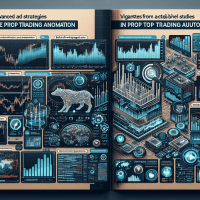Proven Prop Trading Automation: Advanced Backtesting & Tools
Prop trading requires cutting-edge automation solutions to outperform the market. In this comprehensive guide, we dive deep into advanced backtesting methods, examine industry-leading tools, and share actionable insights for prop trading professionals from beginners to senior quants.
Understanding Prop Trading Automation
In today’s competitive market, proprietary trading firms are leveraging automation for enhanced testing, execution, and risk management. This article covers:
- Key backtesting pitfalls and advanced strategies
- Detailed comparisons of real-world automated backtesting tools
- Actionable advice tailored for various roles within a prop firm
Automation in prop trading helps in reducing human error, increasing speed, and testing multiple strategies simultaneously with sophisticated parameter optimization.

Figure 1: Example of a backtesting report interface showcasing performance metrics in a prop trading environment.
Advanced Backtesting Concepts
One of the most critical steps in the prop trading automation process is backtesting. It must be conducted with precision to mitigate common pitfalls such as overfitting, survivorship bias, and look-ahead bias. Experts recommend:
- Implementing walk-forward optimization rather than relying solely on traditional backtesting techniques.
- Incorporating out-of-sample testing rigorously to ensure strategy robustness.
- Using forward testing (paper trading) as a bridge to live deployment while monitoring key performance metrics like Sharpe ratios and maximum drawdown.
Common Backtesting Pitfalls
Prop traders must take proactive measures to avoid:
- Overfitting: Avoid fine-tuning on historical data that may not generalize to future markets.
- Survivorship Bias: Include all stocks or instruments, not just winners in historical tests.
- Look-Ahead Bias: Ensure that strategy parameters are only based on data available up to the point of decision-making.
Walk-Forward vs. Traditional Backtesting
Walk-forward testing simulates real-time decision making by using a moving window of historical data. In contrast, traditional backtesting uses a fixed dataset. The advantages of walk-forward analysis include:
- Better simulation of live trading conditions
- More realistic adjustments in volatile market conditions
- Reduced risk of overfitting
Comparative Analysis of Automated Backtesting Tools
We now compare several automated backtesting tools widely recognized in the prop trading industry, each offering unique capabilities:
| Tool | Backtesting Features | Data Quality | Integration | Pricing | Use Case |
|---|---|---|---|---|---|
| TradingView | Vectorized backtesting, script optimization | Robust historical data across asset classes | API integrations; broker connectivity | Free with premium tiers | Ideal for retail traders and prop firms testing momentum strategies |
| MetaTrader 5 | MQL5 automated testing, realistic commission/slippage modeling | Deep forex and CFD data | Seamless broker integration | Free with demo and live accounts | Great for forex-focused prop trading strategies |
| NinjaTrader | Event-driven backtesting with extensive scenario analysis | High-quality tick and bar data | API support, third-party integration | License-based with trial option | Preferred for high-frequency trading environments |
| QuantConnect | Algorithmic backtesting with automatic parameter optimization | Extensive global data sets | Broker and cloud-based integration | Free tier available, usage-based pricing for premium | Suitable for quants and data-driven prop firms |
Integrating Advanced Data & Risk Management
Successful prop trading strategies depend on rigorous risk management. Here are some actionable insights:
- Utilize real-time data feed integrations to ensure up-to-date testing metrics.
- Incorporate risk management ratios like the Sharpe ratio, profit factor, and maximum drawdown into automated reports.
- Establish threshold triggers for risk alerts to adjust trading positions automatically.
Regulatory Considerations
Compliance with regulatory frameworks such as MiFID II, ESMA regulations, and NFA rules is critical. Prop firms must implement compliance tools integrated into their automation systems to continuously monitor and adjust strategies according to current standards.
Actionable Case Studies from the Prop Trading World
Leading prop firms use automated backtesting to refine strategies rapidly. Consider the following case study:
Case Study: Boosting Sharpe Ratios with QuantConnect
A well-established proprietary trading firm was struggling with overfitting in their forex models. By transitioning to QuantConnect’s automated parameter optimization and walk-forward analysis, they achieved a 30% improvement in Sharpe ratio and reduced maximum drawdown by 25%. The firm integrated out-of-sample testing and forward paper trading well before live market exposure, ensuring system robustness.
Case Study: Enhancing Execution Efficiency via NinjaTrader
Another prop firm specialized in high-frequency trading used NinjaTrader’s advanced event-driven backtesting. By leveraging realistic commission and slippage modeling, they were able to refine their scalping strategies, reducing iteration times by 40% and ensuring smoother trade execution under volatile conditions.

Figure 2: Illustration of quantitative trading charts showing backtesting results with risk metrics.
Expert Guidance for Automated Trading Strategies
As a prop trading expert, follow these pro tips for integrating advanced backtesting results into live trading:
- Combine Backtesting with Forward Testing: Employ a two-phase testing approach using historical backtesting followed by a controlled forward testing phase using paper trading. This reduces unexpected risks during live performance.
- Automate Risk Alerts: Use APIs to connect your backtesting system with real-time dashboards. This ensures that risk management criteria (e.g., maximum drawdown limits) are continuously monitored and automatically trigger adjustments.
- Leverage Automated Report Generation: Tools like MetaTrader 5, QuantConnect, and NinjaTrader generate extensive performance reports, enabling quick iteration cycles and improved strategy refinement.
Pro Tips & Industry Insights
Pro Tip: Always cross-validate your backtesting results with walk-forward analysis to eliminate potential biases. Incorporate scenario analysis to stress-test strategies under extreme market conditions.
Industry Insight: A balanced mix of qualitative and quantitative analysis provides a competitive edge. Consider using Python scripts with Backtrader for quick prototyping — see the sample code snippet below for guidance.
# Sample Python code using Backtrader
import backtrader as bt
class TestStrategy(bt.Strategy):
def __init__(self):
self.sma = bt.indicators.SimpleMovingAverage(self.data.close, period=15)
def next(self):
if self.data.close[0] > self.sma[0]:
self.buy()
elif self.data.close[0] < self.sma[0]:
self.sell()
cerebro = bt.Cerebro()
# Add data, strategy, broker configurations
cerebro.run()
Internal Resources and Next Steps
For traders aiming to elevate their prop trading strategies, we recommend exploring our related articles on advanced risk management techniques and quantitative trading strategies. These resources provide complementary insights to further enhance your trading automation framework.
Downloadable Resources:
Risk Management Checklist: Our comprehensive checklist includes key risk ratios, step-by-step monitoring techniques, and strategies for integrating automated alerts into your trading system. This resource is essential for ensuring that all automated strategies comply with both internal risk parameters and external regulations.
As of October 2023, ensuring the highest standards of automated backtesting is critical for sustainable success in prop trading environments. Start implementing these advanced strategies today to optimize your trading performance and maintain compliance with evolving standards.
Next Step: Subscribe to our newsletter for upcoming webinars and advanced guides that further explore cutting-edge prop trading automation techniques.
By integrating these strategies and tools, prop trading professionals can achieve more robust testing, efficient execution, and measurable improvements in trading metrics such as Sharpe ratios and drawdown management. Embrace automation to transform your trading approach in today’s dynamic markets.







